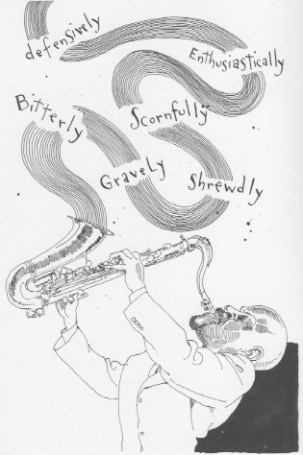At first glance, I thought that this book would be great for anyone who is currently writing fiction, or even creative nonfiction, without any problem. These are the writers who have ideas, and they can get them on paper, although the writing that results is humdrum and lackluster, just lying on the page without arousing anyone’s interest, including the author’s.
Having read the book, I realized I was right. If that’s you in the last paragraph, this book can help you.
But I also realized that the reason a lot of people can’t even begin to get words down on paper is because they suffer anxiety over certain points in writing, such as dialogue attribution, a problem that Elmore Leonard easily solves in rule #3: “Never use a verb other than ‘said’ to carry dialogue,” and in rule #4: “Never use an adverb to modify the word ‘said’…” Notice that he doesn’t quibble; he doesn’t say “try to avoid most of the time using.”
“But,” the aspiring writer interjected boldly. “Aren’t there exceptions? Aren’t there always exceptions?” To which Elmore Leonard responds
The line of dialogue belongs to the character; the verb is the writer sticking his nose in. But “said” is far less intrusive than”grumbled,” “gasped,” “cautioned,” “lied.” I once noticed Mary McCarthy ending a line of dialogue with “she asservated,” and had to stop reading and go to the dictionary. (23)
This is Elmore Leonard, and he makes his living by writing, which means he makes his living by reading. If you want to send your readers to the dictionary, go ahead. But when most readers come across the phrase “she asservated” they don’t go to the dictionary. They go back to the library and get a different book.
So if you are a writer struggling to find your voice, this book will help, because at its core, it is insisting that you throw out anything and everything that prevents your voice form coming through. You would do well to type up Leonard’s ten rules and hang them over your writing desk.

If you teach writing, however, this is a useful book to stuff into the hands of all those aspiring, yet struggling, writers you face, whether they’re in middle school, college, or even beyond. Because this book was originally an article published in the New York Times, it is a quick read, which gives a tremendous sense of accomplishment. (Hey, how many of us can claim to have read a book in less than ten minutes?) But the quirky, sedate drawing by Joe Ciardiello lend the book an odd sort of energy that will draw students in. They’ll probably pay more attention to this book than to you.
And that’s okay, really. A good teacher knows when to get out of their student’s way.
Just like a good writer knows when to get out of their reader’s way. (See rule #10.)
November 2010
Availability
Apparently this book is out of print. But you can still buy it from Amazon.
Work Cited
Leonard, Elmore. Elmore Leonard’s 10 Rules of Writing. Illus. Joe Ciardiello. New York: William Morrow-HarperCollins, 2007.
https://bookblog.kjodle.net/2010/11/28/elmore-leonards-10-rules-of-writing/
